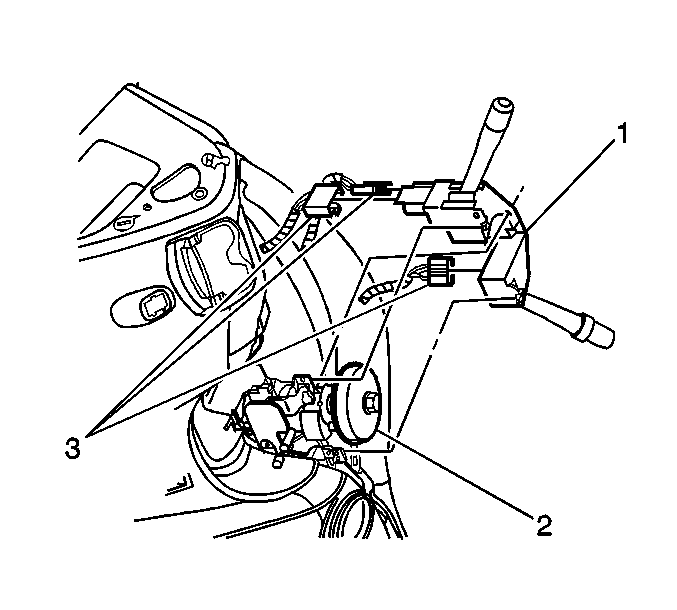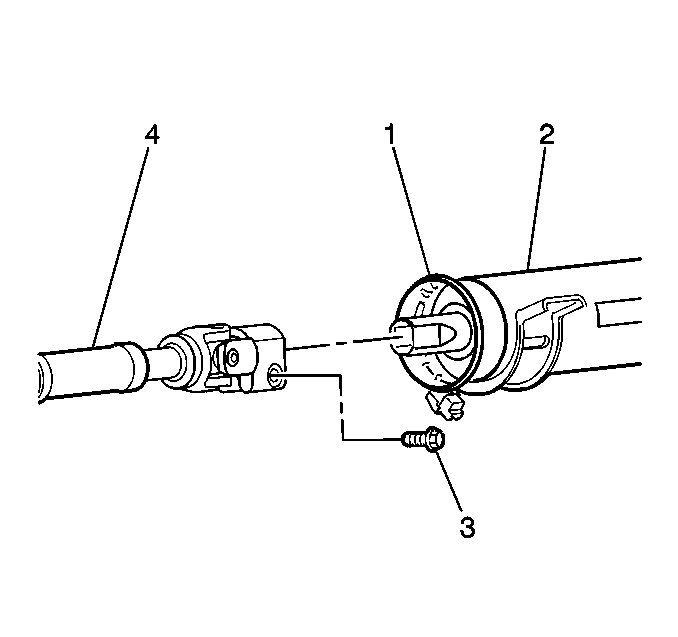Removal Procedure
- Disable the supplemental inflatable restraint (SIR) system. Refer to Disabling the SIR System in SIR.
- Remove the steering wheel. Refer to Steering Wheel Replacement .
- Remove the trim covers. Refer to Steering Column Trim Covers Replacement - On Vehicle .
- Disconnect the electrical connectors (3) from the multifunction switch (1).
- Remove the electrical harness from the steering column.
- Remove the SIR coil. Refer to Inflatable Restraint Steering Wheel Module Coil Replacement in SIR.
- Remove the driver's insulator panel. Refer to Instrument Panel Insulator Panel Replacement - Left Side in Instrument Panel, Gages, and Console.
- Remove the upper pinch bolt (3) from the intermediate shaft (4).
- Remove the steering column lower mounting bolts (3).
- Remove the steering column upper mounting bolts (1).
- Remove the steering column (2) from the vehicle.



Notice: Once the steering column is removed from the vehicle, the column is extremely susceptible to damage. Dropping the column assembly on the end could collapse the steering shaft or loosen the plastic injections, which maintain column rigidity. Leaning on the column assembly could cause the jacket to bend or deform. Any of the above damage could impair the columns collapsible design. Do NOT hammer on the end of the shaft, because hammering could loosen the plastic injections, which maintain column rigidity. If you need to remove the steering wheel, refer to the Steering Wheel Replacement procedure in this section.
Installation Procedure
- Install the steering column (2) in the vehicle.
- Install the steering column lower mounting nuts (3).
- Install the steering column upper mounting bolts (1).
- Install the upper pinch bolt (3) to the intermediate shaft (4).
- Install the SIR coil. Refer to Inflatable Restraint Steering Wheel Module Coil Replacement in SIR.
- Connect the electrical connectors (3) to the multifunction switch (1).
- Install the electrical harness to the steering column.
- Install the trim covers. Refer to Steering Column Trim Covers Replacement - On Vehicle .
- Install the driver's insulator panel. Refer to Instrument Panel Insulator Panel Replacement - Left Side in Instrument Panel, Gages, and Console.
- Install the steering wheel. Refer to Steering Wheel Replacement .
- Enable the SIR system. Refer to Enabling the SIR System .

Caution: In order to ensure the intended function of the steering
column in a vehicle during a crash and in order to avoid personal injury to
the driver, perform the following:
• Tighten the steering column lower fasteners before you tighten
the steering column upper fasteners. Failure to do this can damage the steering
column. • Tighten the steering column fasteners to the specified torque.
Overtightening the upper steering column fasteners could affect the steering
column collapse.
Notice: Use the correct fastener in the correct location. Replacement fasteners must be the correct part number for that application. Fasteners requiring replacement or fasteners requiring the use of thread locking compound or sealant are identified in the service procedure. Do not use paints, lubricants, or corrosion inhibitors on fasteners or fastener joint surfaces unless specified. These coatings affect fastener torque and joint clamping force and may damage the fastener. Use the correct tightening sequence and specifications when installing fasteners in order to avoid damage to parts and systems.
Tighten
Tighten the bolts to 26 N·m (19 lb ft).
Tighten
Tighten the bolts to 26 N·m (19 lb ft).

Tighten
Tighten the bolt to 22 N·m (16 lb ft).

